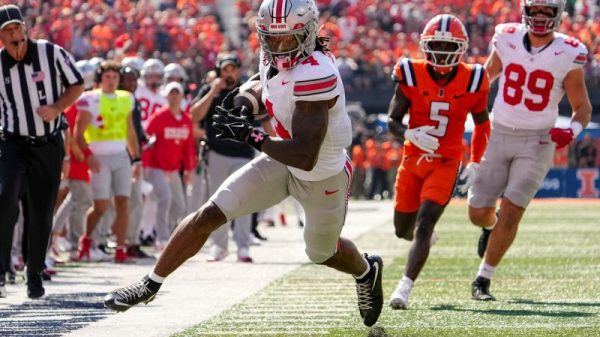The Supreme Court on Tuesday refused Alabama’s attempt to hold 2024 elections under a new congressional map judged to be an unlawful attempt to diminish the power of the state’s Black voters.
It was the second time in four months that the high court has sided with a three-judge panel that found that Alabama’s legislature probably violated the Voting Rights Act by failing to create a second congressional district where minority voters have a large enough share of the electorate to elect their candidate of choice. The state has seven districts, and its voting population is about 27 percent Black.
The court gave no reason for denying Alabama’s request, as is customary in emergency filings, and there were no noted dissents. But for those challenging the map, the order was seen as a blunt statement that Alabama public officials had not attempted to comply with the court’s earlier order.
“Alabama’s open defiance of the Voting Rights Act stops today,” said Abha Khanna, a lawyer for one set of plaintiffs in the challenge. “For the second time this year, the U.S. Supreme Court rejected the state’s attempt to subject Alabama voters to a discriminatory congressional map.”
The case has been closely watched because of an unprecedented number of challenges to congressional maps that are advancing in courts throughout the country, enough to give one political party or the other an advantage heading into the 2024 elections. The map courts envision for Alabama, for instance, could mean a second Democrat in the state’s congressional delegation. Meanwhile, federal judges in Georgia and Louisiana have found similar Voting Rights Act violations in maps from those states.
Alabama essentially had asked the Supreme Court to revisit the issue of voting rights in the state only months after the justices unexpectedly rejected the earlier version of Alabama’s congressional districting map, citing the landmark civil rights law.
That June ruling came as something of a surprise because the Supreme Court’s conservative majority had signaled that it was suspicious of some sections of the Voting Rights Act, and was thought to be sympathetic to Alabama’s argument that the court’s precedents improperly required legislatures to prioritize race over traditional redistricting techniques.
But Chief Justice John G. Roberts Jr. and fellow conservative Justice Brett M. Kavanaugh joined the court’s three liberals in upholding the decision of the lower court, which said the state’s 2021 redistricting packed many of the state’s Black voters into one district, with the rest spread among others so that their voting power is diluted.
The three lower court judges who ruled against Alabama’s map — two of them nominated by President Donald Trump — were applying Section 2 of the Voting Rights Act, which forbids practices that would mean racial minorities “have less opportunity than other members of the electorate to participate in the political process and to elect representatives of their choice.”
The judges concluded that Alabama lawmakers should have drawn a second district “in which Black voters either comprise a voting-age majority or something quite close to it.”
After the Supreme Court ruling, the lower court judges allowed the Alabama legislature the first crack at coming up with a new plan. But instead of creating a second Black district, the lawmakers drew one in which Black people made up about 40 percent of the population.
Drawing a district with a greater Black population, Alabama Attorney General Steve Marshall (R) said in a filing to the Supreme Court, would require the state to “sacrifice traditional districting criteria to join voters from different communities, based on their race, to hit a 50 percent racial target, ‘or something quite close to it.’”
Alabama’s latest version of its congressional map includes only one majority-Black district
Share of Black adults,
by congressional district
0
20
40
60%
50.65%
Each dot represents 1 Black adult
Huntsville
Birmingham
Tuscaloosa
Phenix
City
7th District
Montgomery
Dothan
Mobile
50 MILES
Source: 2020 Census, TIGER/Line, Alabama state
legislature
Alabama’s latest version of its congressional map includes only one majority-Black district
Share of Black adults,
by congressional district
Each dot represents 1 Black adult
Huntsville
0
20
40
60%
Birmingham
50.65%
Tuscaloosa
Phenix
City
7th District
Montgomery
Dothan
Mobile
50 MILES
Source: 2020 Census, TIGER/Line, Alabama state legislature
The lower court said the legislature had defied it and the Supreme Court.
“We are not aware of any other case in which a state legislature — faced with a federal court order declaring that its electoral plan unlawfully dilutes minority votes and requiring a plan that provides an additional opportunity district — responded with a plan that the state concedes does not provide that district,” the judges wrote in a nearly 200-page order. “The law requires the creation of an additional district that affords Black Alabamians, like everyone else, a fair and reasonable opportunity to elect candidates of their choice.”
The panel of judges directed a special master and cartographer to propose three districting plans that are legally compliant. Those plans, submitted Monday, each contain a second district in which Black voters are either a majority or close to it. The three-judge panel is scheduled to meet next week to choose one.
The same panel had found a previous congressional map likely violated the Voting Right Act. But the Supreme Court stayed that ruling because a majority said it came too close to the 2022 election. As a result, that election was held using that map, even though it had been found unlawful. That map split the state’s Black Belt region, which is named for its fertile soil but is also where Black voters are concentrated in the state, along with its major cities.
A group of plaintiffs represented by the Legal Defense Fund and ACLU said Tuesday that the legal fight should now be over.
“It has been a long and frustrating battle holding the Alabama Legislature accountable, but today it is a rewarding one,’ the statement said. “Even after the highest court in the land sided with Black voters in June, our elected officials still chose power over people by outright defying multiple court orders, and the loud cries of their constituents to do the right thing.”
The new district and additional representation in Congress, the statement said, ‘will undoubtedly change lives, especially for the hundreds of thousands of Alabamians residing in the Black Belt . . . We look forward to a new era in our state’s history, in which power is shared and Black voices are heard.”



























